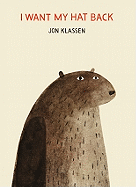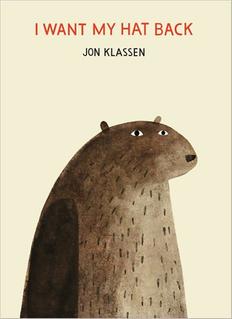
 Hats off to Jon Klassen (Cats' Night Out), who makes a droll statement about morality for all ages with the first picture book that he has both written and illustrated. His limited palette in earth tones, bare-bones compositions and spare dialogue accentuate the emotional journey of his bear hero.
Hats off to Jon Klassen (Cats' Night Out), who makes a droll statement about morality for all ages with the first picture book that he has both written and illustrated. His limited palette in earth tones, bare-bones compositions and spare dialogue accentuate the emotional journey of his bear hero.
"My hat is gone. I want it back," the bear states simply at the story's start. No one else is visible. A few blades of grass and stones against a cream-colored background suggest an outdoor setting. His expression here is the same one he wears on the book's cover. As the story progresses, Klassen demonstrates what the slightest shift of the shape of the eyes or a change in posture can do to convey his character's mood. The bear meets a fox. "Have you seen my hat?" The bear's question is printed in New Century Schoolbook black type, like Dick and Jane primers. The fox's response appears in brown: "No. I haven't seen your hat." "OK. Thank you anyway," the bear answers in black type. This exchange sets up the story's structure; the clever design dispenses with the need for quotation marks. Next, the bear asks a frog about his hat. The frog responds in green type, "No. I have not seen any hats around here." With each encounter, Klassen places the scene on the left, and the dialogue on the right-hand page. The third character the bear meets, a rabbit, sports a red triangle on his head. "Have you seen my hat?" "No. Why are you asking me. I haven't seen it," the rabbit replies in red, "I would not steal a hat. Don't ask me any more questions." "OK. Thank you anyway," goes the hero's polite refrain, and on he searches.
Even if young readers make a connection at this point that the bear does not, the suspense builds. The bear meets other creatures after the rabbit, including a turtle whom he kindly helps to mount a rock. But no one has seen his hat. The bear lies down on the bottom of the spread, and his thoughts appear above him. "What if nobody ever finds it? My poor hat. I miss it so much." A deer comes along and asks the bear to describe his hat, and that triggers the epiphany. Klassen uses the turn of the page brilliantly for the climax: "I HAVE SEEN MY HAT." The bear literally sees red; he sits up on a tomato-colored page that infuses his fur. Klassen, with a background in animation, paces the next spreads like film sequences. A wordless image depicts the woodland creatures looking on as the bear runs to his hat. Next, the words "YOU. YOU STOLE MY HAT" appear on the right, above a full-spread illustration, as if the bear burst into the rabbit's habitat (the same unique twig partially masks the culprit). The once-verbose rabbit says nothing, but his eyes grow large. Then, the bear wears the hat. Alone. "I love my hat." One last conversation (with a new arrival, a squirrel) suggests what may have transpired, a perfect echo of the bear's exchange with the rabbit. The beauty of a visual solution is that it allows children not ready for a worst-case scenario to assume another outcome. This book's call-and-response form infiltrates the consciousness like song lyrics, and will soon be filling bookstores, libraries and living rooms everywhere.--Jennifer M. Brown

